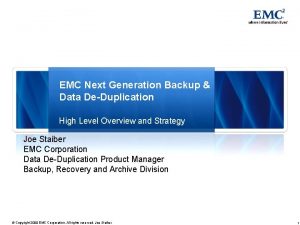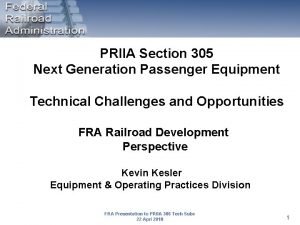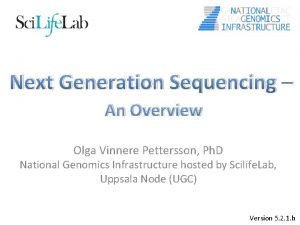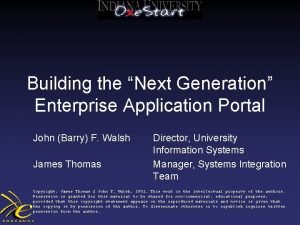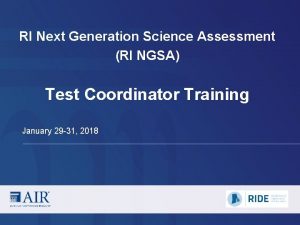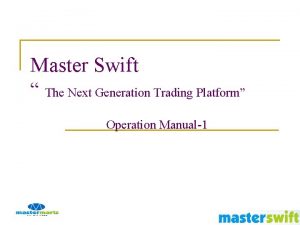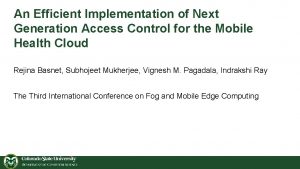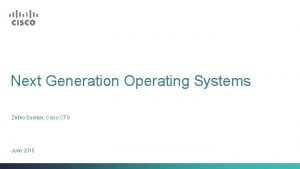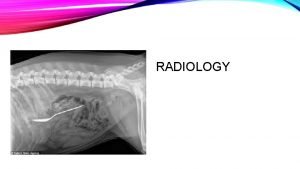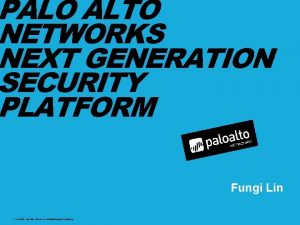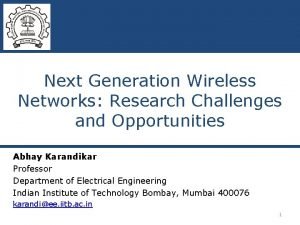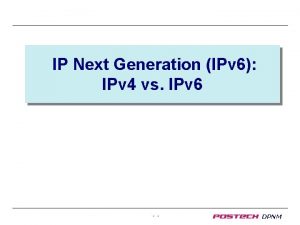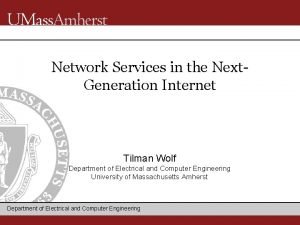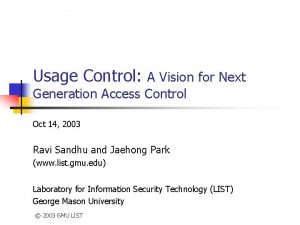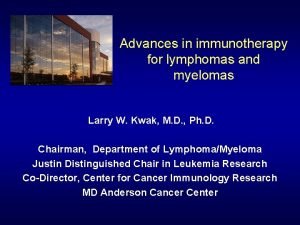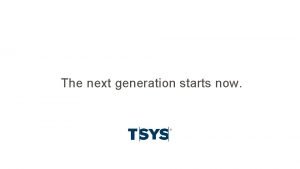IP Next Generation IPv 6 IPv 4 vs



















































- Slides: 51

IP Next Generation (IPv 6): IPv 4 vs. IPv 6 - - DPNM

Table of Contents v Limitations of current Internet Protocol (IPv 4) v How many addresses do we need? v IPv 6 addressing v IPv 6 header format v IPv 6 features: routing flexibility, plug-n-play, multicast support, flows -2 - DPNM

Pre-IP: Translation, ALGs ALG ALG v Application-Layer Gateways (ALGs) – – inevitable loss of some semantics difficult to deploy new Internet-wide applications hard to diagnose and remedy end-to-end problems stateful gateways hard to route around failures v No global addressability – ad-hoc, application-specific solutions -3 - DPNM

The IP Solution … IP IP v Internet-layer gateways & global addresses v Simple, application-independent, lowest denominator network service: best-effort datagrams v Stateless gateways could easily route around failures v with application-specific knowledge out of gateways: – Network service providers (NSPs) no longer had monopoly on new services – Internet: a platform for rapid, competitive innovation -4 - DPNM

The Internet Today: with NATs NAT-ALG IP v Network Address Translators (NATs) and App-layer gateways (ALGs) – – – inevitable loss of some semantics hard to diagnose and remedy end-to-end problems stateful gateways inhibit dynamic routing around failures no global addressability => brokered with NATs new Internet devices more numerous, and may not be adequately handled by NATs (e. g. , mobile nodes) -5 - DPNM

IPv 4 Addresses v Example: 164. 107. 134. 5 = 1010 0100 : 0110 1011 : 1000 0110 : 0000 0101 = A 4: 6 B: 86: 05 (32 bits) v Maximum number of address = 232 = 4 Billion v Class A Networks: 15 Million nodes v Class B Networks: 64, 000 nodes or less v Class C Networks: 250 nodes or less v Class B very popular… v Total allocated address space as seen by routing: ~1 Billion -6 - DPNM

How Many Addresses? v 10 Billion people by 2020 v Each person has more than one computing device v Assuming 100 devices person 1012 devices v More addresses may be required since – Multiple interfaces per node – Multiple addresses per interface – Some believe 26 to 28 addresses per host v Safety margin 1015 addresses v IPng Requirements 1012 end systems and 109 networks. Desirable 1012 to 1015 networks -7 - DPNM

IPv 6 Addresses v 128 -bit long. Fixed size v 2128 = 3. 4× 1038 addresses 665× 1021 addresses per sq. m of earth surface v If assigned at the rate of 106/ s, it would take 20 years v Expected to support 8× 1017 to 2× 1033 addresses 8× 1017 1, 564 address per sq. m v Allows multiple interfaces per host. v Allows multiple addresses per interface v Allows unicast, multicast, anycast v 85% of the space is unassigned -8 - DPNM

Colon-Hex Notation v Dot-Decimal: 127. 23. 45. 88 v Colon-Hex: FEDC: 0000: 3243: 0000: ABCD – Can skip leading zeros of each word – Can skip one sequence of zero words, e. g. , FEDC: : 3243: 0000: ABCD or : : 3243: 0000: ABCD – Can leave the last 32 bits in dot-decimal, e. g. , : : 127. 23. 45. 88 – Can specify a prefix by /length, e. g. , 2345: BA 23: 7: : /40 -9 - DPNM

Header v IPv 6: Version Class Flow Label Payload Length Next Header Hop Limit Source Address Destination Address IPv 4: Version IHL Type of Service Total Length Identification Flags Fragment Offset Time to Live Protocol Header Checksum Source Address Destination Address Options Padding q - 10 - DPNM

The IPv 4 Header Version Hdr Len Prec TOS Total Length Identification Flags Fragment Offset Time to Live Protocol Header Checksum Source Address Destination Address Options Padding 32 bits v shaded fields are absent from IPv 6 header - 11 - DPNM

IPv 6 vs. IPv 4 v IPv 6 twice the size of IPv 4 header v Version: only field with the same position and meaning v Removed: – Header length, fragmentation fields (identification, flags, fragment offset), header checksum v Replaced: – – Datagram length by payload length Protocol type by next header Time to live by hop limit Type of service by “class” octet v Added: flow label v All fixed size fields. v No optional fields. Replaced by extension headers. – Idea: avoid unnecessary processing by intermediate routers w/o sacrificing the flexibility - 12 - DPNM

Extension Headers Base Extension Header 1 Extension Header n Data v Most extension headers are examined only at destination v Routing: Loose or tight source routing v Fragmentation: one source can fragment v Authentication v Hop-by-Hop Options v Destination Options: - 13 - DPNM

Extension Header (Continued) o Only Base Header: Base Header Next = TCP o TCP Segment Only Base Header and One Extension Header: Base Header Route Header Next = TCP o TCP Segment Only Base Header and Two Extension Headers: Base Header Route Header Auth Header Next = TCP Next = Auth Next = TCP - 14 - TCP Segment DPNM

Fragmentation v Routers cannot fragment. Only source hosts can. Need path MTU discovery or tunneling v Fragmentation requires an extension header v Payload is divided into pieces v A new base header is created for each fragment . . . Part n Base Header Data New Base Header Frag. 1 Header Part 1 New Base Header Frag. 2 Header Part 2 New Base Header Frag. n Header Part n Part 1 - 15 - DPNM

Initial IPv 6 Prefix Allocation Reserved Unassigned NSAP IPX Unassigned Prefix Allocation 0000 Unassigned 0000 0001 Unassigned 0000 010 Unassigned 0000 011 Unassigned 0000 1 Unassigned 0001 Unassigned Provider-based* 010 Link-Local Unassigned 011 Site-Local Geographic 100 Multicast Prefix 101 110 1111 110 1111 1110 11 1111 *Has been renamed as “Aggregatable global unicast” - 16 - DPNM

Aggregatable Global Unicast Addresses (1) v Address allocation: “provider-based” plan v Format: TLA + NLA + SLA + 64 -bit interface ID v TLA = “Top level aggregator. ” – For “backbone” providers or “exchange points” v NLA = “Next Level Aggregator” – Second tier provider and a subscriber – More levels of hierarchy possible within NLA v SLA = “Site level aggregator” – Renumbering: change of provider => change the TLA and NLA. But have same SLA & I/f ID v Sub-fields variable-length, non-self-encoding - 17 - DPNM

Aggregatable Global Unicast Addresses (2) v Interface ID = 64 bits – Will be based on IEEE EUI-64 format – An extension of the IEEE 802 (48 bit) format. – Possible to derive the IEEE EUI-64 equivalent of current IEEE 802 addresses 001 TLA NLA* public topology (45 bits) SLA* interface ID site topology (16 bits) - 18 - interface identifier (64 bits) DPNM

IPv 6 Routing architecture TOP Next level Provider, Exchange Next level Site Link Host - 19 - DPNM

Local-Use Addresses v Link Local: Not forwarded outside the link, FE: 80: : xxx – Auto-configuration and when no routers are present 10 bits 1111 1110 10 q q 118 -n Interface ID Site Local: Not forwarded outside the site, FE: C 0: : xxx Independence from changes of TLA / NLA* 10 bits 1111 1110 11 q n bits 0 n bits m bits 118 -n-m bits 0 SLA* Interface ID Provides plug and play - 20 - DPNM

Multicast Addresses 1111 flags scope 8 4 group ID 112 bits 4 v low-order flag indicates permanent / transient group; three other flags reserved v scope field: 1 - node local 2 - link-local 5 - site-local 8 - organization-local B - community-local E - global (all other values reserved) v All IPv 6 routers will support native multicast - 21 - DPNM

Multicast Scoping v Scoping. Eg: 43 NTP Servers – – – FF 01: : 43 All NTP servers on this node FF 02: : 43 All NTP servers on this link FF 05: : 43 All NTP servers in this site FF 08: : 43 All NTP servers in this org. FF 0 F: : 43 All NTP servers in the Internet v Structure of Group ID: – First 80 bits = zero (to avoid risk of group collision, because IP multicast mapping uses only 32 bits) - 22 - DPNM

Address Auto-configuration v Allows plug and play v BOOTP and DHCP are used in IPv 4 v DHCPng will be used with IPv 6 v Two Methods: Stateless and Stateful v Stateless: – A system uses link-local address as source and multicasts to "All routers on this link" – Router replies and provides all the needed prefix info – All prefixes have a associated lifetime – System can use link-local address permanently if no router - 23 - DPNM

Address Auto-configuration (Continued) v Stateful: – Problem with stateless: Anyone can connect – Routers ask the new system to go DHCP server (by setting managed configuration bit) – System multicasts to "All DHCP servers" – DHCP server assigns an address - 24 - DPNM

ICMPv 6: Neighbor Discovery v ICMPv 6 combines regular ICMP, ARP, Router discovery and IGMP. v The “neighbor discovery” is a generalization of ARP & router discovery. v Source maintains several caches: – – destination cache: dest neighbor mapping neighbor cache: neighbor IPv 6 link address prefix cache: prefixes learnt from router advertisements router cache: router IPv 6 addresses - 25 - DPNM

Neighbor Discovery (Continued) v Old destination look up destination cache v If new destination, match the prefix cache. If match destination local! v Else select a router from router cache, use it as the nexthop (neighbor). – Add this neighbor address to the destination cache v Solicitation-advertisement model: – Multicast solicitation for neighbor media address if unavailable in neighbor cache – Neighbor advertisement message sent to soliciting station. - 26 - DPNM

IPv 6 Auto-configuration: 7 problems v 1. End-node acquires L 3 address: – Use link-local address as src and multicast query for advts – Multiple prefixes & router addresses returned v 2. Router finds L 3 address of end-node: same net-ID v 3. Router finds L 2 address of end-node: neighbor discovery (generalization of ARP, w/ several caches) v 4. End-nodes find router: solicit/listen for router advt v 5. End-nodes send directly to each other: same prefix (prefix cache) => direct v 6. Best router discovery: ICMPv 6 redirects v 7. Router-less LAN: same prefix (prefix cache) => direct. Link-local addresses + neighbor discovery if no router. - 27 - DPNM

Auto-Reconfiguration (“Renumbering”) v Problem: providers changed => old-prefixes given back and new ones assigned THROUGHOUT the site v Solution: – we assume some overlap period between old and new, i. e. , no “flash cut-over” – hosts learn prefix lifetimes and preferability from router advertisements – old TCP connections can survive until end of overlap; new TCP connections can survive beyond overlap v Router renumbering protocol, to allow domain-interior routers to learn of prefix introduction / withdrawal v New DNS structure to facilitate prefix changes - 28 - DPNM

Other Features of IPv 6 v Flow label for more efficient flow identification (avoids having to parse the transport-layer port numbers) v Neighbor un-reachability detection protocol for hosts to detect and recover from first-hop router failure v More general header compression (handles more than just IP+TCP) v Security (“IPsec”) & differentiated services (“diff-serv”) Qo. S features — same as IPv 4 - 29 - DPNM

If IPv 6 is so great, how come it is not there yet? v Applications – Need upfront investment, stacks, etc. – Similar to Y 2 K, 32 bit vs. “clean address type” v Networks – Need to ramp-up investment – No “push-button” transition - 30 - DPNM

Transition Issues: Protocol upgrades v Most application protocols will have to be upgraded: FTP, SMTP, Telnet, Rlogin v Several full standards revised for IPv 6 v Non-IETF standards: X-Open, Kerberos, . . . will be updated… Hosts, routers … the works! v With a suite of “fixes” to IPv 4, what is compelling in IPv 6? – Sticks: tight address allocation (3 G going to IPv 6), NAT becomes too brittle… – Incentives (carrots): stateless autoconf simplifies mobility, if p 2 p and multimedia grow, then NATs may pose a problem - 31 - DPNM

Transition Mechanisms v 1. Recognize that IPv 4 will co-exist with IPv 6 indefinitely v 2. Recognize that IPv 6 will co-exist with NATs for a while v Dual-IP Hosts, Routers, Name servers v Tunneling IPv 6 -over-IPv 4 (6 -over-4), IPv 4 as link (6 -to-4) v Translation: allow IPv 6 -only hosts to talk to IPv 4 -only hosts Application Dual Internet TCP IPv 4 IPv 6 Ethernet IPv 4 - 32 - DPNM

IPv 4 -IPv 6 Co-Existence / Transition Three categories: (1) dual-stack techniques: allow IPv 4 and IPv 6 to coexist in the same devices and networks (2) tunneling techniques: avoid order dependencies when upgrading hosts, routers, or regions (3) translation techniques: allow IPv 6 -only devices to communicate with IPv 4 -only devices v. Expect all of these to be used, in combination - 33 - DPNM

Dual-Stack Approach v When adding IPv 6 to a system, do not delete IPv 4 – this multi-protocol approach is familiar and well-understood (e. g. , for Apple. Talk, IPX, etc. ) – note: in most cases, IPv 6 will be bundled with new OS releases, not an extra-cost add-on v Applications (or libraries) choose IP version to use – when initiating, based on DNS response: if (dest has AAAA or A 6 record) use IPv 6, else use IPv 4 – when responding, based on version of initiating packet v This allows indefinite co-existence of IPv 4 and IPv 6, and gradual, app-by-app upgrades to IPv 6 usage - 34 - DPNM

Tunneling v Encapsulate IPv 6 inside IPv 4 packets (or MPLS). Methods: – – Manual configuration “Tunnel brokers” (using web-based service to create a tunnel) “ 6 -over-4” (intra-domain, using IPv 4 multicast as virtual LAN) “ 6 -to-4” (inter-domain, using IPv 4 addr as IPv 6 site prefix) v can view this as: – IPv 6 using IPv 4 as a virtual link-layer, or – an IPv 6 VPN (virtual public network), over the IPv 4 Internet (becoming “less virtual” over time) - 35 - DPNM

6 to 4 Automated tunneling across IPv 4… Pure “Version 6” Internet Original “Version 4” Internet 1 v 4 address = 6 to 4 Site 1 v 6 network - 36 - DPNM

6 to 4 addresses: 1 v 4 address = 1 v 6 network FP (3 bits) TLA (13 bits) IPv 4 Address (32 bits) SLA ID (16 bits) Interface ID (64 bits) 001 0 x 0002 ISP assigned Locally administered Auto configured v Stateless tunnel over the IPv 4 network without configuration – The IPv 6 address contains the IPv 4 address – Entire campus infrastructure fits behind single IPv 4 address - 37 - DPNM

Translation: path from NATs v May prefer to use IPv 6 -IPv 4 protocol translation for: – new kinds of Internet devices (e. g. , cell phones, cars, appliances) – benefits of shedding IPv 4 stack (e. g. autoconfig) v Simple extension to NAT techniques, to translate header format as well as addresses – IPv 6 nodes behind a translator get full IPv 6 functionality when talking to other IPv 6 nodes located anywhere – they get the normal (i. e. , degraded) NAT functionality when talking to IPv 4 devices – methods used to improve NAT functionality (e. g, ALGs, RSIP) can be used equally to improve IPv 6 -IPv 4 functionality v Alternative: transport-layer relay or app-layer gateways - 38 - DPNM

Network Address Translation and Protocol Translation (NAT-PT) IPv 6 -only devices NAT-PT IPv 4 -only and dual-stack devices - 39 - DPNM

RSIP-based evolution leads to IPv 6 IPv 4 Crisis IPv 4+NAT Broken. . . Realm-Specific IP (RSIP) IPv 4+RSIP Unlikely direction… Future proof. . . IPv 6+RSIP Backbone. . . Since RSIP is not gaining traction IPv 6 - 40 - DPNM

Standards v core IPv 6 specifications are IETF Draft Standards well-tested & stable – IPv 6 base spec, ICMPv 6, Neighbor Discovery, Multicast Listener Discovery, PMTU Discovery, IPv 6 -over-Ethernet, . . . v other important specs are further behind on the standards track, but in good shape – mobile IPv 6, header compression, A 6 DNS support, IPv 6 -over-NBMA, . . . – for up-to-date status: playground. sun. com / ipng v the 3 GPP cellular wireless standards are highly likely to mandate IPv 6 - 41 - DPNM

Implementations v most IP stack vendors have an implementation at some stage of completeness – some are shipping supported product today, e. g. , 3 Com, *BSD, Epilogue, Ericsson/Telebit, IBM, Hitachi, KAME, Nortel, Sun, Trumpet – others have beta releases now, supported products “soon”, e. g. , Cisco, Compaq, HP, Linux community, Microsoft – others known to be implementing, but status unkown • e. g. , Apple, Bull, Mentat, Novell, SGI (see playground. sun. com/ipng for most recent status reports) v good attendance at frequent testing events - 42 - DPNM

6 -bone etc… v Experimental infrastructure: the 6 bone – for testing and debugging IPv 6 protocols and operations – mostly IPv 6 -over-IPv 4 tunnels – > 200 sites in 42 countries; mostly universities, network research labs, and IP vendors v Production infrastructure in support of education and research: the 6 ren – CAIRN, Canarie, CERNET, Chunghwa Telecom, Dante, ESnet, Internet 2, IPFNET, NTT, Renater, Singren, Sprint, SURFnet, v. BNS, WIDE – a mixture of native and tunneled paths – see www. 6 ren. net, www. 6 tap. net v Few commercial trials by ISPs announced - 43 - DPNM

Incentive: Peer-to-peer applications? 4255551212 - 44 - DPNM

Problem 1: Peer-to-peer RTP audio example P 1 P 2 Home LAN NAT Internet NAT Home LAN v With NAT: – – Need to learn the address “outside the NAT” Provide that address to peer Need either NAT-aware application, or application-aware NAT May need a third party registration server to facilitate finding peers - 45 - DPNM

Solution 1: Peer-to-peer RTP audio example P 1 P 2 Home LAN Home Gateway Internet Home Gateway Home LAN v With IPv 6: – Just use IPv 6 address - 46 - DPNM

Problem: Multiparty Conference P 1 P 2 Home LAN NAT Internet NAT Home LAN P 3 v With NAT, complex and brittle software: – – 2 Addresses, inside and outside P 1 provides “inside address” to P 3, “outside address” to P 2 Need to recognize inside, outside P 1 does not know outside address of P 3 to inform P 2 - 47 - DPNM

Multiparty IPv 6 Conference P 1 P 2 Home LAN P 3 Home Gateway Internet Home Gateway Home LAN v With IPv 6: – Just use IPv 6 addresses - 48 - DPNM

Key drivers? Parting thoughts … v Always-on requirement large number of actively connected nodes online v 3 G, Internet appliances – large numbers of addresses needed in short order… – IPv 6 auto-configuration and mobility model better – 3 GPP already moving towards IPv 6 v P 2 P apps and multimedia get popular and NAT/ALGs/Firewalls break enough of them v Multi-homed sites and traffic engineering hacks in BGP/IPv 4 make inter-domain routing un-scalable v Dual stack, simpler auto-conf, automatic tunneling (6 to 4, etc. ) simplify migration path and provide installed base – Applications slowly start self-selecting IPv 6 - 49 - DPNM

Summary v IPv 6 uses 128 -bit addresses v Allows provider-based, site-local, link-local, multicast, anycast addresses v Fixed header size. Extension headers instead of options for provider selection, security etc v Allows auto-configuration v Dual-IP, 6 -to-4 etc for transition - 50 - DPNM

Question and Discussion - 51 - DPNM
 X.next = x.next.next
X.next = x.next.next You're good and your mercy is forever
You're good and your mercy is forever Second generation vs first generation antipsychotics
Second generation vs first generation antipsychotics Next generation network definition
Next generation network definition Palo alto traps gartner
Palo alto traps gartner Next generation text service
Next generation text service Tonio thomas
Tonio thomas Next generation enterprise network
Next generation enterprise network Nclex clinical judgement model
Nclex clinical judgement model Next generation backup
Next generation backup Priia 305
Priia 305 Hn next gen
Hn next gen Next generation sequencing methods
Next generation sequencing methods Vendor management matrix
Vendor management matrix Fondi next generation eu
Fondi next generation eu Next generation learning standards nys
Next generation learning standards nys Nys next generation math standards
Nys next generation math standards Next generation assessments
Next generation assessments Next generation sequencing
Next generation sequencing Next gen nclex
Next gen nclex Next generation enterprise applications
Next generation enterprise applications Foothill deca
Foothill deca Next generation soc
Next generation soc Educating the next generation of leaders
Educating the next generation of leaders Next generation solution
Next generation solution Ngsa testing
Ngsa testing Ngss california
Ngss california Next generation lms
Next generation lms The next generation
The next generation Trojan uv swift sc manual
Trojan uv swift sc manual Palo alto traps gartner
Palo alto traps gartner Next generation emr
Next generation emr Financial literacy grade 8
Financial literacy grade 8 Next generation eu immagini
Next generation eu immagini Financial literacy grade 9
Financial literacy grade 9 Next generation access control
Next generation access control Electrical energy
Electrical energy Next-generation smart contracts
Next-generation smart contracts Hp-hvof
Hp-hvof Pengertian ngn
Pengertian ngn Next generation operating system
Next generation operating system Next generation radiology
Next generation radiology Palo alto networks next generation security platform
Palo alto networks next generation security platform Next generation sequencing methods
Next generation sequencing methods Next generation learning challenges
Next generation learning challenges Next generation wireless communication market
Next generation wireless communication market Ip next generation
Ip next generation Argos next generation
Argos next generation Network as a service for next generation internet
Network as a service for next generation internet Mic next generation sequencing
Mic next generation sequencing Next generation access control
Next generation access control Next generation vaccine
Next generation vaccine









